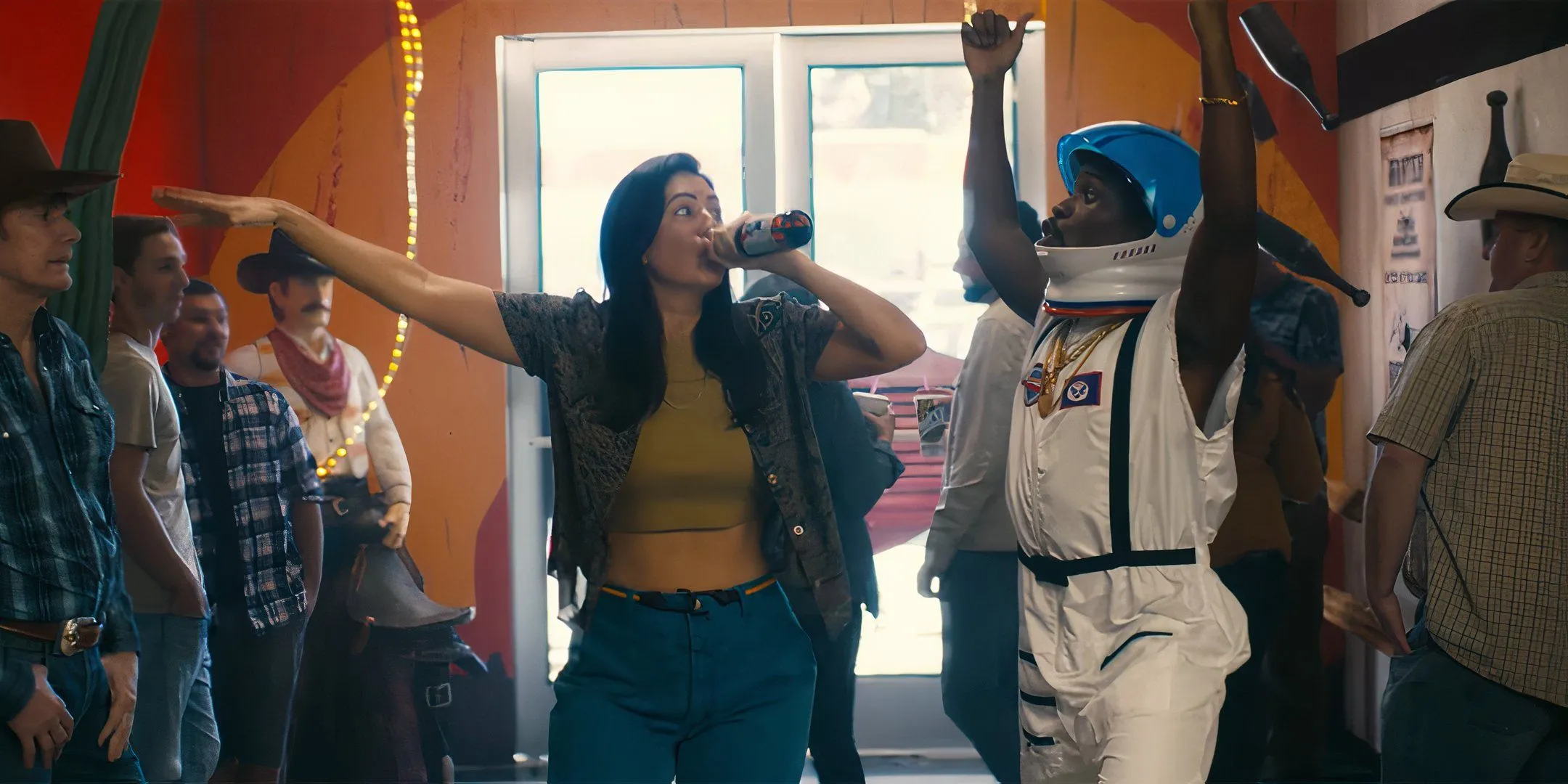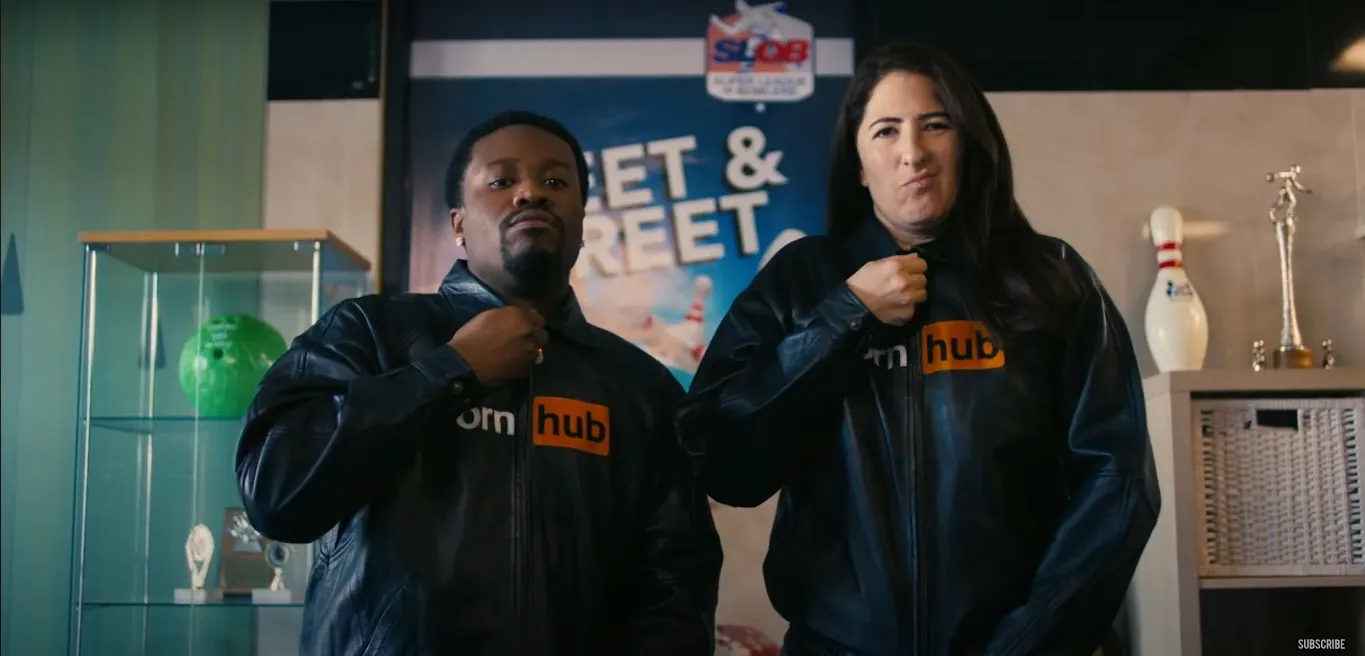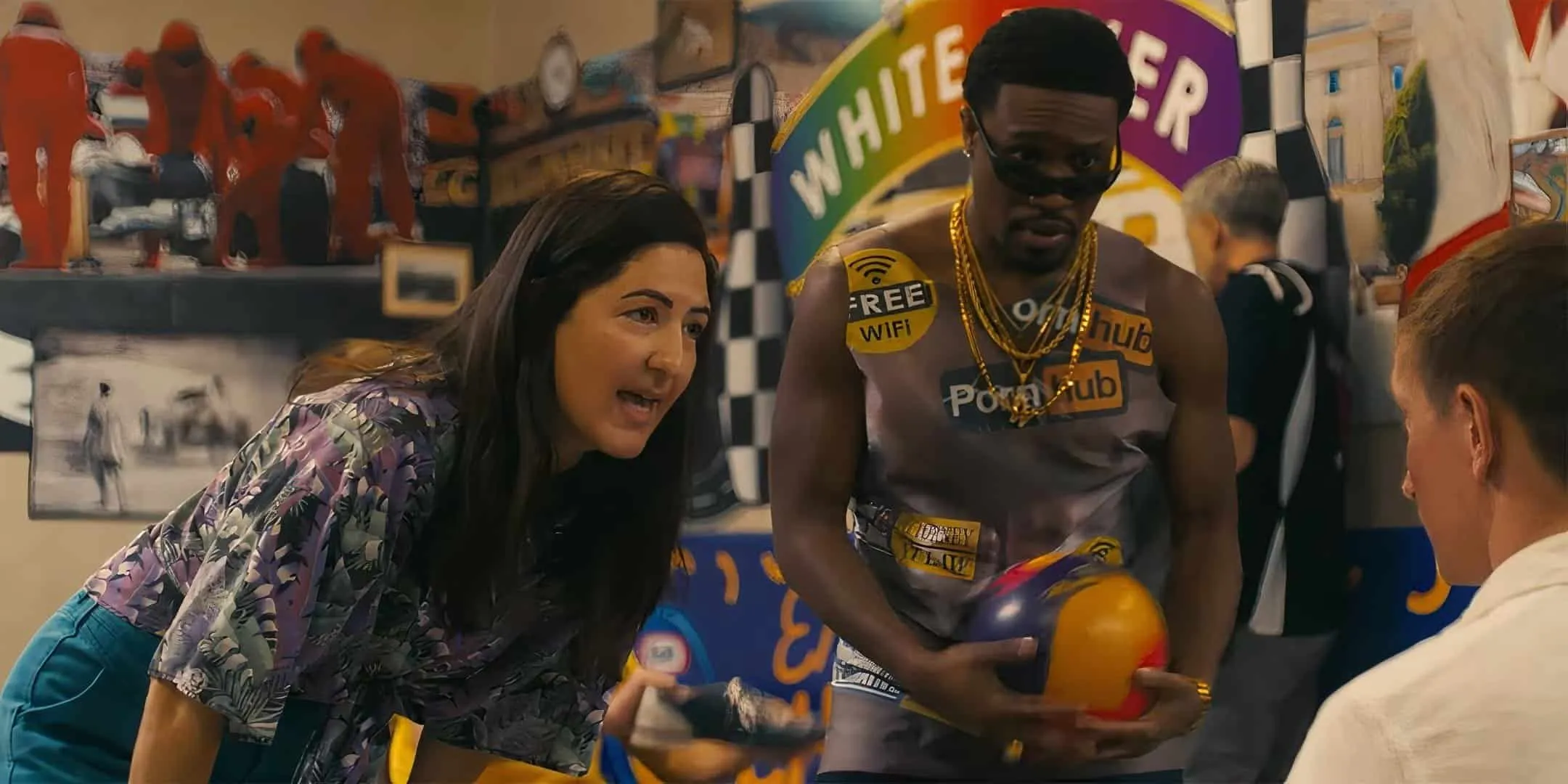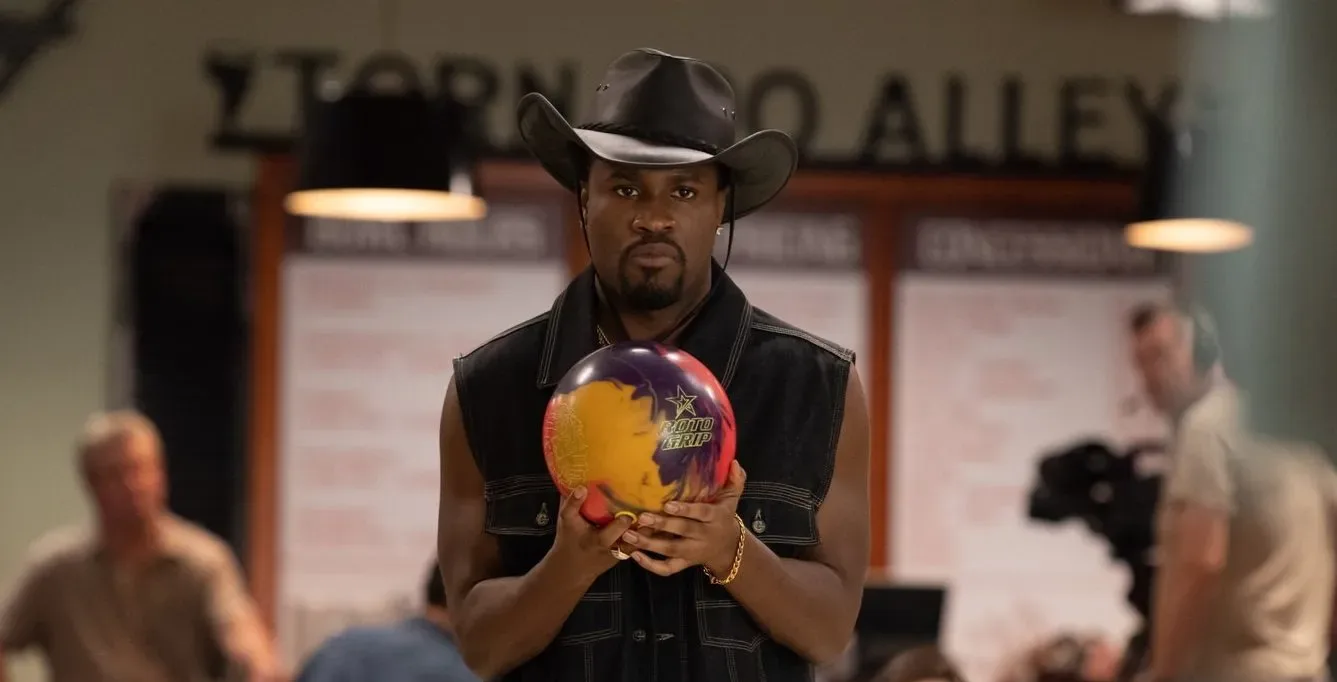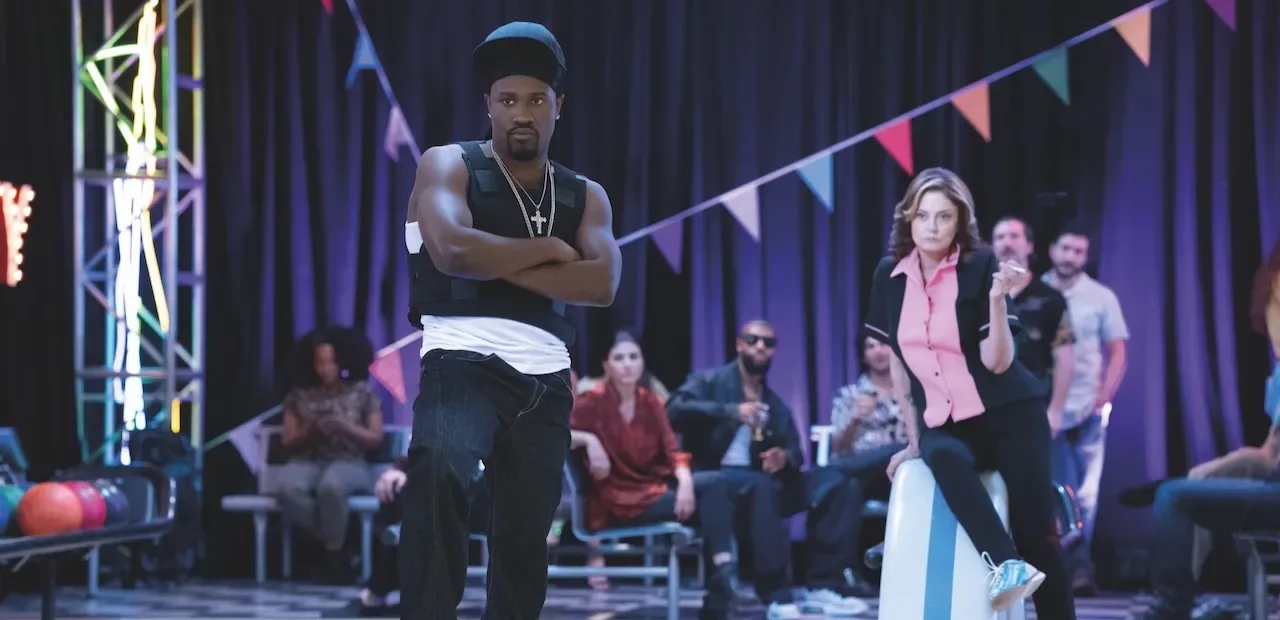The AlleyCatz bowling alley setting in “The Gutter” serves as more than just a background; it captures the financial difficulties and cultural vitality of a community on the verge of collapse. AlleyCatz looks like it’s from a better time, with its dull brick exterior and worn-out lanes.
It’s like Walt’s life, as he jumps from job to job without a shirt on, representing humor and hopelessness. This setting creates the stage for a narrative that breaks the rules of traditional storytelling, much like the French New Wave filmmakers I admire, who frequently found beauty in the ordinary.
Walt’s character is a happy mess, the perfect loser, and Shameik Moore plays him with contagious energy. Along with his introduction as a lost bartender who always makes mistakes, a funny story about his past firings adds both sympathy and humor. The event that starts the fight is a health inspector’s harsh report: AlleyCatz must make $200,000 in repairs within 60 days, or it will have to close.
This moment is crucial because it puts Walt in a narrative with a lot on the line and forces him to overcome his flaws. The stakes are high, echoing a cultural worry about unstable economies and the struggle for community survival—themes that are very relevant to the current state of the economy.
As a film reviewer, I value how “The Gutter” deftly weaves these narrative threads together, turning what could have been a simple sports comedy into a reflection of larger social changes. In a world that frequently feels fixed against you, the film not only entertains but also makes a point about how dangerous dreams can be.
Characters in “The Gutter”: A Colorful Tapestry of Flaws and Aspirations
Walt, played by Shameik Moore with great charm, is the perfect example of an adorably crazy anti-hero. His personality is a blend of confidence and not knowing what’s happening. He often goes from making you laugh out loud to having deep, meaningful realizations about the course of his life. Despite having a lens that frequently leans toward the absurd, Walt’s goals are refreshingly straightforward and incredibly relatable: he wants recognition and success.
His character arc reflects a battle against self-doubt and societal expectations as he navigates his chaotic journey from a shirtless bartender to a professional bowler, reminiscent of the flawed protagonists found in Noah Baumbach’s works, where personal growth is messy but necessary.
D’Arcy Carden’s Skunk serves as the film’s anchor. Skunk’s character adds depth to the narrative as a former professional bowler who is struggling with her problems, such as alcoholism and a tense relationship with her mother, Linda. Her interactions with Walt are complex; she moves back and forth between being a mentor and an unwilling partner, providing comic relief and emotional weight. Skunk sees in Walt a chance to regain her lost glory while assisting him in navigating the absurdities of competitive bowling, and their interaction perfectly captures the film’s study of redemption.
The supporting characters Mozell, Linda, and Brotha Candy further enrich the film’s narrative. Linda, a retired bowling legend, represents the haunting legacy of past successes and failures. At the same time, Mozell, the weary owner of AlleyCatz, embodies the struggles of small business owners in a changing market.
Brotha Candy, a street preacher with outrageous conspiracy theories, highlights the film’s interaction with modern cultural anxieties and adds humor and social commentary to the mix. Each character, with their quirks and flaws, serves a purpose beyond comic relief; they represent Walt and Skunk’s journeys, making “The Gutter” not only a comedy but a vibrant tapestry of human experience in the face of adversity.
Thematic Layers in “The Gutter”: Race, Identity, and the Absurd
In a sport like bowling, frequently referred to as the “whitest sport,” “The Gutter” navigates the complex terrain of race and identity within competitive sports. Walt’s journey into this field as a Black character is a personal and cultural commentary. Using humor as a lens to explore serious themes, the film seriously considers the obstacles people of color face in places where most people are white.
Walt’s antics, like his daring way of bowling and crazy stage name, go against the common stereotypes in these places and show that ability doesn’t depend on race. This narrative resonates with larger cultural changes, echoing a generation that wants to be treated fairly and recognized in all areas.
“The Gutter” embodies the standard underdog story, which is heartwarming and funny. Walt’s journey from being a hopeless bartender to a professional bowler shows how he can find strength and self-discovery. This trope is used in an innovative way that feels both familiar and fresh, reminiscent of films like “Rocky” or “The Pursuit of Happiness.”
But the film cleverly goes against what you might expect by adding absurdity to the narrative and showcasing how success can come from chaos instead of normal hard work. This delightful turn of events reflects the unpredictability of life. This thought often comes to mind in the jazz improvisations I love, where the unexpected can lead to the most meaningful moments.
The film’s comedic storytelling relies heavily on absurdity, creating a vibrant web of character interactions that keeps the audience interested. Walt ends up in some pretty crazy situations, like bowling games with Pornhub stickers on his face. These situations are both funny and a sharp critique of society. The film goes beyond just being entertaining because of this blend of humor and absurdity; it reflects how surreal the world we live in is frequently. By incorporating these absurd elements, “The Gutter” creates a funny and thought-provoking narrative, echoing the innovative storytelling methods of directors like Godard and Baumbach, who conflate the lines between comedy and cultural criticism.
The Humor of “The Gutter”: A Delightful Blend of Absurdity and Insight
Throughout “The Gutter,” humor is a powerful tool that can be used with accuracy and chaos. The film’s comedic style skillfully mixes slapstick and absurdism, creating both thought-provoking and hilarious moments. Much like the works of great comedies, it makes you think of “Kingpin” and “The Big Lebowski,” but it stands out by making social commentary a part of its comedy.
The Lesters use physical comedy and crazy situations, reminiscent of the French New Wave’s playful narrative style, where the unexpected is the most important thing. With humor that feels both current and delightfully unfiltered, this modern take on absurdity resonates with the current cultural climate.
The film has a unique comedic style and frequently moves between highbrow and lowbrow humor. One of the funniest jokes is about Walt’s crazy sponsorship deals, in which he puts Pornhub stickers on his bare chest, which causes both laughter and eyebrows to rise.
Not every joke works the same way. For example, some of Skunk’s more random comments, like her love of warm beer, occasionally cross into the realm of absurdity that feels unconnected to the narrative flow. Instead, the film’s playful embarrassment of unpredictability is highlighted by these errors, which do not significantly lessen the overall effect.
“The Gutter” is different because it uses humor to question social norms and expectations, making it more than just a bunch of jokes. The laughter often has many layers that show deeper truths about race, identity, and aspiration. It appeals to audiences, echoing the comedic styles of modern filmmakers like Greta Gerwig, who blends humor with deep social insight. In this way, “The Gutter” is a vibrant example of the effectiveness of comedy as a tool for cultural reflection. It makes people laugh while also making them consider the world in a critical light.
Direction and Production in “The Gutter”: A Fresh Take on Comedy
Yassir and Isaiah Lester’s choices as directors in “The Gutter” show a vibrant blend of irreverence and heart, making it a notable addition to modern cinema. Their vision comes from having a great sense of comedic timing, balancing slapstick humor with touching character development moments with ease.
The Lesters embrace spontaneity, allowing the actors’ improvisational skills to shine, much like the playful experimentation found in the films of the French New Wave. This method draws attention to the absurdities in their narrative and helps the characters and the audience feel more connected.
The cinematography and editing are very important to the film’s comedic tone. With its changing angles and smooth movements, the camera work captures the crazy energy of the bowling alley and its strange customers. I particularly like how each frame feels alive, echoing the spontaneity of jazz improvisation.
The film’s humor is amplified by quick cuts and well-timed pauses, reminiscent of the sarcastic wit in old comedies. The audience is kept interested, while brief periods of reflection between bouts of laughter are allowed, thanks to the seamless transitions between scenes. These components work together to produce a film that feels both innovative and approachable, paving the way for a new wave of comedic storytelling.
Cameos and Supporting Roles in “The Gutter”: A Delightful Ensemble
The numerous memorable cameos elevate ” The Gutter’s” comedic charm and narrative depth. Notable performances include Kim Fields as Walt’s financially struggling mother, whose comedic timing and relatable struggles add warmth to the film.
Playing a snarky bowling commentator, Paul Reiser injects a satirical edge that both critiques and celebrates the world of professional bowling, reminiscent of his sharp wit in projects like “Mad About You.”
These supporting characters enrich the film’s landscape, providing comic relief and important context for Walt’s journey. Each cameo serves a specific purpose in advancing the plot or amplifying the humor, creating a tapestry of interactions that reflect the film’s themes of aspiration and community. Their presence reinforces the idea that success is often a collaborative effort, echoing the spirit of ensemble-driven narratives I admire in films by directors like Greta Gerwig. The result is a vibrant, engaging experience that resonates with audiences on multiple levels.
Final Thoughts on “The Gutter”: A Bold Addition to Comedy
“The Gutter” is a refreshing blend of humor, heart, and social commentary, showcasing the talents of the Lester brothers in a way that feels both innovative and approachable.
Its strengths lie in its vibrant character dynamics, clever comedic timing, and a narrative that tackles race and identity in a unique context.
While some jokes may hit or miss, the film’s overall charm and engaging performances more than compensate for these small shortcomings.
In a comedy landscape often dominated by formulaic narratives, “The Gutter” is a bold, entertaining work that challenges conventions and resonates with contemporary societal shifts.
The Review
The Gutter
"The Gutter" is a lively, absurdist comedy that expertly handles themes of race and identity while providing laugh-out-loud moments and a novel take on the underdog story. Lester's direction shines through its funny and interesting performances, making it a great addition to the comedy genre. Even though not every joke works, the movie's heart and wit make up for it and leave a lasting impact.
PROS
- Unique blend of absurd humor and social commentary.
- Engaging performances from the cast, particularly in supporting roles.
- Innovative direction by the Lester brothers that captures spontaneity.
- Strong character dynamics that resonate with contemporary issues.
- Visually dynamic cinematography and clever editing contribute to comedic timing.
CONS
- Some jokes may not land effectively, feeling disconnected.
- Certain plot points can be predictable within the genre.
- The narrative occasionally sacrifices depth for humor.









































